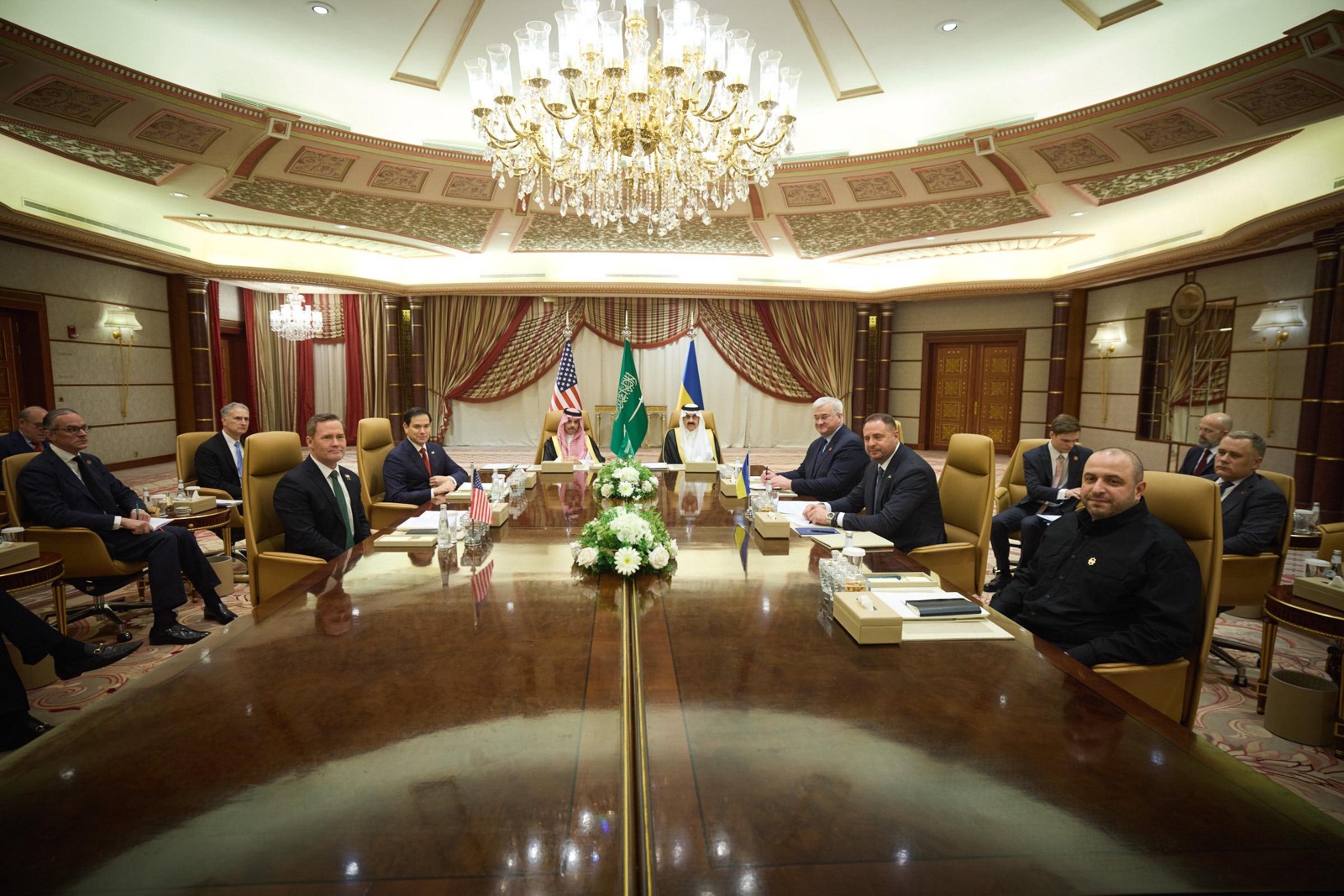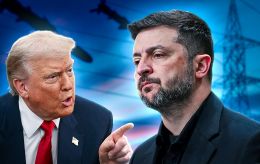Ceasefire or imitation? Has Russia stopped shelling energy sector and what's Putin up to
 Repair of a power facility after shelling (photo: GettyImages)
Repair of a power facility after shelling (photo: GettyImages)
Russia and Ukraine have declared their readiness not to shell energy facilities. However, despite Putin's statements, the aggressor country continues to terrorize Ukrainian cities with Shaheds every night. Whether the so-called energy truce is working – in the RBC-Ukraine's article below.
Contents
During a meeting with US officials in Jeddah on March 11, the Ukrainian delegation agreed to a full 30-day ceasefire, provided Russia also agreed. Donald Trump was supposed to present this proposal to the Russian side. However, after a personal conversation between Putin and Trump a week later, the US demand for a complete ceasefire was lost amid broader formulations and more modest "successes."
The White House release following the call stated that "the path to peace will begin with a cessation of attacks on energy and infrastructure." Trump himself wrote about Moscow’s agreement to an "immediate ceasefire on all energy and infrastructure."
Meanwhile, the Kremlin's release stated that Putin was ready for a "mutual renunciation of strikes for 30 days" only "on energy infrastructure objects" and supposedly immediately issued the corresponding order to his military. Volodymyr Zelenskyy also agreed to halt strikes on Russian energy facilities.
Washington decided to present all of this as yet another "victory," despite the fact that Russia continues nightly attacks on Ukrainian regions with hundreds of Shaheds, their modifications, and decoy targets — "dummy drones."
Ceasefire, but not quite
Daily Russian long-range drone attacks have continued since September. Occasionally, Moscow has carried out a series of combined attacks, launching both UAVs and missiles simultaneously at Ukrainian regions. The last such attack occurred on March 7.
Over these months, Russia has honed its drone attack tactics. The enemy directs swarms of drones—both strike and decoy—at a single target to overload Ukrainian air defenses. Additionally, these drones maneuver in altitude during their approach — flying too high, then too low — causing them to disappear from radar. In one night, Russians can launch between 100 and 200 such UAVs. All of this combined makes interception more difficult.
While in December, enemy strikes focused on electricity generation and transmission facilities, by January, their focus had shifted to Ukraine's gas transportation system.
However, sources in the military told RBC-Ukraine that since March 19, after Trump's conversation with Putin, Russian missiles and drones have not attacked Ukrainian energy facilities. Likewise, after Zelenskyy agreed to the "energy ceasefire," Ukraine has not carried out strikes on Russian energy infrastructure, including oil refineries.
For at least a year, Ukraine’s defense forces have systematically attacked Russian oil refineries to both deprive the occupation army of fuel and reduce the Kremlin's ability to finance its aggressive war.
"It looks like the Russians haven't targeted energy for nearly a week. Since March 19, such strikes have not been recorded. We'll see how this develops, as nothing has been formally documented yet," said one source.

Consequences of the Russian missile attack on Sumy on March 24 (photo: Suspilne Sumy)
If one monitors information on Russian and Ukrainian attacks, there have been no public reports (from reliable sources, not the Russian Defense Ministry) of energy infrastructure being hit on either side since Trump's conversation with Putin and Zelenskyy’s subsequent statement.
However, according to presidential advisor Dmytro Lytvyn, since March 18, there have been eight confirmed Russian strikes on Ukrainian energy facilities. Lytvyn stated that since then, Russia has attacked Ukrainian energy sites using bombs, strike drones, and FPV drones.
Meanwhile, Moscow continues to terrorize Ukraine nightly with hundreds of Shaheds and strikes on other targets. According to sources, most of Russia’s long-range drones over the past week have targeted military facilities, airfields, railways, and defense industry sites.
At the same time, there has been no significant change in the number of Shaheds launched over the past week. Moreover, according to RBC-Ukraine, Russia has opened three new UAV launch sites near Primorsko-Akhtarsk and the seven already operational. This could allow the aggressor to increase the number of Shaheds launched in a single attack in one day or night.
Of course, not all Russian drones fly precisely or follow correct coordinates, which means they incidentally hit Ukrainian civilian targets. However, it cannot be ruled out that some strikes are deliberately terrorist, specifically targeting civilian buildings.
What's next
It is worth noting that this so-called energy ceasefire is currently happening "by default" — the cessation of strikes on energy infrastructure and the control over its adherence are neither documented nor formally agreed upon. Even after the US negotiations with Ukraine and Russia in Saudi Arabia in recent days, statements from the parties regarding strikes on energy infrastructure differ.
The White House stated that they would work with both Ukraine and Russia to develop a mechanism for prohibiting strikes on energy facilities. Ukrainian officials announced that it was agreed to "implement agreements on a complete ban on strikes on Ukraine's and Russia's energy infrastructure."
According to President Zelenskyy, the cessation of attacks on energy facilities would take effect immediately after a corresponding statement from the US side. Meanwhile, the Kremlin stated that Russia and the US "agreed to develop measures to prohibit strikes on energy facilities in Russia and Ukraine for 30 days, starting March 18, 2025."
At the same time, Zelenskyy said that Kyiv had given the Americans a list of energy facilities that a moratorium on strikes should cover. Meanwhile, the Kremlin also published a list of energy sites that should not be targeted, claiming it had been agreed upon with the US. This includes refineries, oil and gas pipelines, gas storage facilities, nuclear power plants, thermal power plants, substations, transformers, distribution centers, and hydroelectric dams.
Alongside discussions on energy strikes, the parties also addressed security at sea, where clarity remains just as elusive. Both the US and Ukraine stated that they would ensure the safety of navigation in the Black Sea, particularly for commercial vessels.
For more than a year and a half, Ukraine’s defense forces have independently ensured such security and the functioning of the grain corridor. What would be relevant for Ukraine is a ban on Russian attacks on its ports, a prohibition on missile-carrying warships and tactical aircraft loaded with missiles operating in the Black Sea. However, whether progress has been made on these issues remains unclear.

If at the previous meeting Ukraine and the US discussed a full ceasefire, this time the focus was only on energy security and maritime safety. (Photo: mfa.gov.ua)
For its part, the Kremlin has put forward its own conditions for ensuring security in the Black Sea—these involve easing sanctions on Russia’s agricultural sector and fertilizer production. Specifically, Moscow wants the resumption of Russian agricultural and fertilizer exports, the lifting of sanctions on Rosselkhozbank, and its reintegration into the SWIFT system. These demands are nearly identical to those Russia presented as ultimatums in the summer of 2023 to continue the grain corridor agreement.
The coming days will show how committed the Kremlin is to fulfilling its obligations — not towards Ukraine, but primarily towards the US. What recent days have demonstrated is that the path to a full ceasefire, let alone the possible end of Russia’s war against Ukraine, will not be quick.
Putin is making every effort to show Trump his willingness to halt hostilities. And perhaps he is not lying about this, as he cannot ignore the fact that the war has reached a stalemate, with neither side capable of making significant breakthroughs on the front. However, when it comes to stopping the fighting, Putin is in no hurry — unlike Trump. That is why the Russian dictator has been playing into Trump’s desire to claim quick victories, offering him small "successes" in exchange for Washington’s concessions.
"Putin is stringing Trump along, appeasing him and playing to his ego. He gives him small victories piece by piece, so Trump can say, 'I achieved this, and then I achieved that.' Meanwhile, he lays out additional conditions for bigger concessions—like, 'We are ready for a full ceasefire, but under these terms.' And then Trump goes off to think about it. But let’s be honest, no fools are sitting in the US administration. The real question is, when will their patience run out, and when will they start pressuring Russia?" speculated one informed source in RBC-Ukraine.
In this Kremlin game, there is significant danger for Ukraine — Moscow could end up receiving all the "carrots," while Kyiv is left with only the "sticks." In the coming months, ensuring a fair distribution of these "sticks" and "carrots" will be the key task for Ukrainian, European, and American diplomacy. The White House must already understand that Ukraine is unlikely to agree to all possible concessions just so that Putin can call it a "victory" and Trump can declare it "the end of the war."

